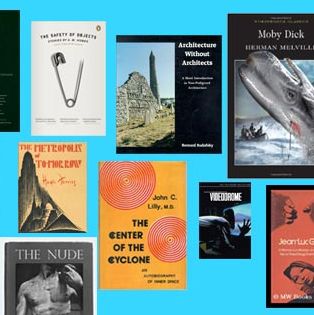
The following recommended reading lists have been excerpted from An Ideal Syllabus: Artists, Critics, and Curators Choose the Books We Need to Read, a slender little book published in 1998 by Frieze and edited by our own Jerry Saltz. “Too many syllabuses I gathered from colleagues and art schools all over the country indicated far too solid a consensus,” wrote Saltz in his introduction, “The same authors are prescribed, chapter for chapter, page for page. If everybody thinks differently how come much of what is assigned to students (at every level) is the same? Large doses of Derrida, Baudrillard and Lacan. If art is pluralistic and composing from all over, why are ideas presented as unified and monolithic? Mighn’t there be an array of more private syllabuses out there? So I asked.” We’re glad he did, and now, with the advent of SEEN, we’re doing it again; in the coming weeks, we’ll be sharing more recently assembled syllabuses from people we admire and respect. For now, we think these hold up pretty well — see who thinks you need to be reading Raymond Carver and who would be lost without Emily Dickinson.
Matthew Barney, artist
• The Thomas Register (Volumes 1–20)
• McMaster Carr Catalogue
• Heinrich von Kleist, Uber Das Marionettentheater (Rohse, 1810). Published in Katherina Fritsch (Museum für Gegenwartskunst, Basel; San Francisco MOMA, 1996)
• Mark Mynsk, Conditioning for Wrestling: The Iowa Way (1982), page 207
• Time Out (Weekly)
♦ ♦ ♦ ♦
Cindy Sherman, artist
• Mad magazines
• Any old magazines (ten years or older)
• Advertisements in tabloid magazines
• Any newspapers
♦ ♦ ♦ ♦
Vito Acconci, artist
• Anthony Greenbank, Everyman’s Guide to Staying Alive and Handling Emergencies in the City, the Suburbs, and the Wild Lands Beyond (HarperCollins, 1968)
Read yourself into situations of crisis and start working from there.
• Bernard Rudofsky, Architecture Without Architects (University of New Mexico Press, 1964)
When you know too much, go back to the ABCs of building and shelter.
• Hugh Ferriss, The Metropolis of Tomorrow (Princeton Architectural Press, 1929)
Architecture of and in the mind: the emergence of architecture out of paper and its disappearance into the air.
• John Hawkes, The Lime Twig (New Directions, 1964)
Come into the dark; enter the precious jewel … The world put into a crystal cage. See, this is what art does; but it’s hard to resist.
• J.G. Ballard, The Atrocity Exhibition (Re/Search Publications; revised, annotated, illustrated edition, 1990)
History in stills; the world as headlines; writing as surgery; art as news.
• Maurice Blanchot, The Writing of the Disaster (University of Nebraska Press, 1980)
Language without things; thought without matter.
• A subscription to wallpaper magazine (Time Inc.)
• A repulsive and fascinating immersion in the (over-designed) products of the (over-affluent) world around (and out of reach of) us.
• As you’re reading, or flipping through pictures, or pages, listen to music in the background: Tricky (Pre-Millennium Tension), or Moby (Everything Is Wrong). And, further in the background, something from the past: The Fall (The Infotainment Scan, 1993), or the Mekons (Mekons, 1980).
• And while you’re taking a break, go out to see a movie — or, better, bring a movie home; from the ‘60s, Godard’s Pierrot Le Fou, or Contempt; from the ‘70s, John Cassavetes’s Killing of a Chinese Bookie, or Brian de Palma’s Phantom of Paradise, or Bob Rafelson’s The King of Marvin Gardens; from the ‘80s. Ridley Scott’s Blade Runner, or David Cronenberg’s Videodrome; from the ‘90s … I don’t know yet; maybe Abel Ferrara’s The Addiction, or Lars von Trier’s Breaking the Waves.
♦ ♦ ♦ ♦
John Currin, artist
• Kenneth Clark, The Nude (John Murray, 1956)
Instead of being organized around “issues” of “the body,” it’s all about the curve of waists and hips, how long arms and necks are, plus the single best description anywhere of a Picasso painting.
• Wyndham Lewis, Tarr (Penguin, 1918)
Imagines Modernist bohemia as a movie by Sam Peckinpah or Don Siegel.
• Herman Melville, Moby Dick (Wordsworth Classics, 1851)
You can load up a ripping yarn with realist detail and get a mind-blowing work of art that remains completely mysterious. It’s the opposite of The Nude: there’s no women or sex, just perverse camaraderie. The White Whale is the biggest nude in the universe, and you can describe its form for 300 pages, but you can never really possess it with your eyes like a painting.
♦ ♦ ♦ ♦
Peter Doig, artist
• Jeffrey Potter, To a Violent Grace: An Oral Biography of Jackson Pollock (Pushcart Books, 1985)
• Gerald Ferguson (ed.), Marsden Hartley and Nova Scotia (1987)
About what inspired the late paintings.
• James M. Cain, The Postman Always Rings Twice (1935)
Visual, narrative power.
• The poems of Billy Childish, usually published by Hangman Books.
Doing it for yourself, by yourself.
• Daniel Clowes, Art School Confidential (Eightball No. 7, 1981)
For those about to apply to art school.
• Philip Guston, lecture transcript from the University of Minnesota, March 1978, in Renee McKee (ed.), Philip Giuston: Paintings 1969–80 (Whitechapel Galler, 1982)
The last entry may be of the “old school” — still good, though.
♦ ♦ ♦ ♦
Jeff Koons, artist
• Soren Kirkegaard, Either/Or (Penguin 1992)
• Jean-Paul Sartre, Being and Nothingness (Washington Square Press, 1943)
• Niccolo Machiavelli, The Prince (Penguin, 1515)
• Patti Smith, Seventh Heaven (Charles River Books, 1978)
♦ ♦ ♦ ♦
Edward Ruscha, artist
• Pliny, The Elder, Natural History — A Selection (Penguin)
• J. Frank Dobie, The Voice of the Coyote (University of Nebraska Press, 1950)
• J.G. Ballard, Crash (Vintage, 1973)
• James Joyce, Ulysses (Penguin, 1973)
• James Joyce, Finnegan’s Wake (Penguin, 1939)
Any two or three pages.
♦ ♦ ♦ ♦
Dave Hickey, critic
Here are some texts I have assigned in theory courses to leaven the dough of genteel materialism that constitutes the bulk of the discourse. There are others, of course, but these have been particularly well received.
• Isaiah Berlin, Four Essays on Liberty (Oxford University Press, 1969)
• Jeremy Gilbert-Rolfe, Beyond Piety, Critical Essays on the Visual Arts, 1986–1993 (Cambridge University Press, 1995).
• Jane Jacobs, Systems of Survival: A Dialogue on the Moral Foundations of Commerce and Politics (Random House, 1992)
• Jacqueline Lichtenstein, The Eloquence of Colour: Rhetoric and Painting in the French Classical Age (Flammarion, 1989)
• Morse Peckham, Explanation and Power: The Control of Human Behavior (The Seabury Press, 1979)
• Tom Peters, Liberation Management (Macmillen, 1992)
• Barbara Maria Stafford, Artful Science: Enlightenment Entertainment and the Eclipse of Visual Education (MIT Press, 1994).
♦ ♦ ♦ ♦
Roni Horn, artist
For its brevity, an agonizing list to select. I make my selection only from artists’ writings, excluding much, especially in philosophy, that I believe would play an important role in a contemporary syllabus. In general, because of its second-generation character, criticism was, and remains, relatively uncompelling for me, though there are exceptions. I also exclude both film and music, although film especially has played an important role in my development.
• Flannery O’Conner, the short-story collection A Good Man Is Hard to Find (Faber & Faber, 1962); Everything That Rises Must Converge (Farrar, Straus, Giroux, 1966); and the prose collection Mystery and Manners (Farrar, Straus, Giroux, 1972).
• Jena-Luc Godard, the screenplays A Woman Is a Woman; A Married Woman; and Two or Three Things I Know About Her (Harper and Row, 1975)
• Louis I. Kahn, The Notebooks and Drawings (M.I.T. Press, 1973)
• Wallace Stevens, Opus Posthumous (Knopf, 1977)
Especially the prose portions, and, for example, the poem “Bouquet of Roses in Sunlight,” in The Collected Poems.
• Paul Valery, The Collected Works (Bollingen); especially volume 7, The Art of Poetry. (1958); volume 8, Leonardo, Poe, Mallarme (1972); volume 13, Aesthetics, (1964); and volume 14, Analects, (1970)
• Emily Dickinson, The Complete Poems (Belknap, 1976)
For example, No. 352.
I have excluded arbitrarily things equally as compelling and important for me … the “beginning of an ideal syllabus” would not mean multimedia exposure of first-generation material not limited by idiom. The weather was always a good place to start. Today it is as well, more so than ever.
♦ ♦ ♦ ♦
Kara Walker, artist
• Susan-Lori Parks, “An equation for Black People Onstage”in Elements of Style and The America Play — perform as class experiment. (Theatre Communications Group, 1995)
• Salman Rushdie, The Satanic Verses (Penguin, 1988)
• Charlie Hayden et al., The Ballad of the Fallen (BMG, 1994)
An amazing recording. I think my class would be ruled with an iron hand, but I’d provide a soundtrack that would fuel the revolutionary spirit.
• Toni Morrison, Playing in the Dark: Whiteness and the Literary Imagination (Vintage, 1993)
• Raphael S. Ezekiel, The Racist Mind; Portraits of American Neo-Nazis and Klansmen (Viking, 1995)
• Sam Keen, Faces of the Enemy; Reflections of the Hostile Imagination (1986)
• Sander Gilman, Difference and Pathology; Stereotypes of Sexuality, Race and Madness (Cornell University Press, 1985)
• Ladislas Bugner (ed.), The Image of the Black in Western Art (Menil Collection, 1983)
♦ ♦ ♦ ♦
Gregory Crewdson, artist
For an emerging generation of artists, the power and complexity of photography resides in its capacity to establish compelling imaginary worlds and psychological dramas in pictures. Much recent photography effortlessly hovers between other narrative forms including film, literature, painting, television, and other cultural representations. Consequently, the most significant source material for understanding the aesthetic and critical issues surrounding photography today exists outside the medium itself. The following list of selected films, writers, and essays are important to the formation of a course syllabus concerning the critical analysis and practice of contemporary photography.
• Alfred Hitchcock, Vertigo (1958)
• Michael Powell, Peeping Tom (1960)
• Charles Laughton, Night of the Hunter (1955)
• David Cronenberg, Videodrone (1982)
• Todd Hayes, Superstar: The Karen Carpenter Story (1987)
• Raymond Carver, Cathedral (Collins, 1983)
• A.M. Homes, The Safety of Objects (Viking 1991)
• Robert Smithson, The Writings of Robert Smithson (New York University Press, 1979)
• Bruno Battelheim, Uses of Enchantment (Thames & Hudson, 1976)
♦ ♦ ♦ ♦
William Kentridge, artist
• Rainer Maria Rilke, the poem “Orpheus, Eurydice, Hermes” (University of California Press, 1923)
For ways of finding new things in old material — and finding a single key node around which to structure a whole work (Eurydice’s “who?”).
• George Herriman, the cartoon Krazy Kat. Perhaps the volume The Komplete Kolor Krazy Kat.
To see how a coherent, consistent new world and vocabulary can be constructed and how to use found landscape — Arizona, I think.
• Dziga Vertov, Man With a Movie Camera (1929)
Yes, I know it’s a film.
• Theodor Adorno, the collection of fragments Minima Moralia (Verso, 1951)
Less intimidating than any unbroken volume on critical theory but with the essence of the theory exemplified in each page or paragraph.
• Ryzard Kapuscinski, The Emperor (Pan, 1983)
An account of the last days of the emperor Haillie Sailassie
♦ ♦ ♦ ♦
Elizabeth Peyton, artist
• Marcel Proust, Remembrance of Things Past (Paris, 1914-27)
• Andy Warhol, The Warhol Diaries (Simon & Schuster, 1989)
• Balzac, Lost Illusions (Penguin, 1937)
• Jon Savage, England’s Dreaming (Faber & Faber, 1991)
• Vincent Cronin, Napoleon (Collins, 1971)
♦ ♦ ♦ ♦
Raymond Pettibon, artist
• Thomas Browne, essays on Gardens, Urn Burial, etc.
• Robert Burton, Anatomy of Melancholy (Essinger)
• Thomas Carlyle, Sartor Resartus (Emerson, 1836)
• John Ruskin, Modern Painters (Penguin, 1843-46)
• Henry James, The Art of Fiction, including the prefaces to his novels, stories, etc. (University of Chicago Press, 1884)
• Also the works of: Proust, Joyce, Pater, Catullus, Sappho, Shakespeare, Marlowe, Donne, Herbert, Milton, Wordsworth … and the rest of the usual suspects — or else write your own.





